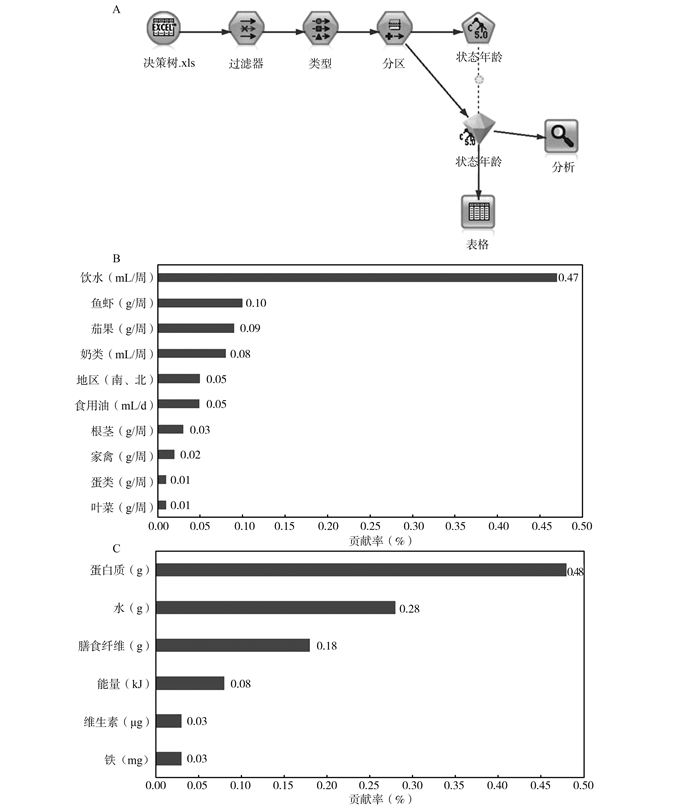Study on screening of daily diet and nutrient anti-aging programs for urban residents based on decision tree model
-
摘要:
目的 分析并筛选社区居民日常饮食-营养素摄入种类、结构、数量等变量,构建抗衰老方案。 方法 选择南北方4省(江西省、福建省、陕西省及甘肃省)部分社区作为研究现场,采用多阶段分层整群抽样,通过生理-心理-社会三维人体衰老度量表(physiological-psycho-social three dimensional aging scale, PPSHAS)测量衰老并调查居民饮食现况。分析被测对象状态年龄、饮食(营养素)谱,以决策树(decision tree, DT)模型筛选变量构建抗衰老方案。 结果 回收有效问卷660份(91.79%),男女比1∶1.2。女性普遍比男性年轻(t=2.317, P=0.018)。总计34.85%的居民状态相对年轻,其差值在(4.37~12.33)岁,40.00%的居民状态相对年老,其差值在3.29~10.53岁。年轻组日常饮食中荤菜(部分)、蔬菜类、奶、水果、坚果、水等摄入量高于年老组(均有P<0.05),日饮水量高出年老组625.15 mL;年老组牛羊肉、食用油摄入量高于年轻组(χ2牛羊肉=15.557, χ2食用油=69.520, P<0.001)。年轻组6类营养素(蛋白质、碳水化合物等)的摄入量均高于年老组(均有P<0.05),而脂类则相反(t=26.173, P<0.001)。获得6种饮食类抗衰老方案,其中抗衰贡献因子排前3的是饮水量(0.47)、鱼虾(0.10)和茄果类(0.08);营养素类4种方案,其中抗衰贡献因子排前3的是蛋白质(0.48)、水(0.28)和膳食纤维(0.18)。 结论 1/3以上的城市居民处于年龄较小状态。主食、荤菜、蔬菜、瓜果、豆类、奶摄入量有抗衰老效应,饮水尤甚;过量脂类摄入不利抗衰老;饮食类抗衰老方案以1、2号最佳,营养素类方案以1号为最佳。 Abstract:Objective The study analyzed and screened the daily diet, nutrient intake type, structure, quantity and other variables of community residents to construct an anti-aging program. Methods Four Provinces in North and South were selected as the research field. We applied the physiological-psycho-social three dimensional aging scale (PPSHAS) scale to measure aging and investigated the dietary status of residents. The Decision Tree model was used to construct the program. Results There were 660 valid questionnaires retrieved (91.79%), with a male to female ratio of 1∶1.2. Women were generally younger than males (t=2.317, P0.018). A total of 34.85 % of inhabitants were 4.37-12.33 years younger, while 40.00 % were 3.29-10.53 years older. In the younger group, the daily intake of meat vegetables (parts), vegetables, milk, fruits, nuts, water, and so on were significantly higher than in the obviously older group (P < 0.05). And the daily water intake was 625.15 mL higher. The latter consumed more beef, mutton and edible oil than the former (χ2beef, mutton =15.557, χ2edible oil=69.520, P < 0.001). In terms of nutrition, the youthful group consumed considerably more (P < 0.05), but the lipid consumption was the invert (t=26.17, P < 0.001). There are six types of dietary anti-aging programs, with the top three anti-aging contributing factors being water intake (0.47), fish and shrimp (0.10), and nightshade (0.08). Four types of nutrient programs, programs with the top three anti-aging factors were protein (0.48), water (0.28), and dietary fiber (0.08). Conclusions With over one-third of urban dwellers are significantly younger. The intake of staple foods, meat vegetables, vegetables, fruits, legumes, and milk were much greater in the youthful group than in the clearly old group, particularly drinking water. Excessive lipid intake is negative to anti-aging. Dietary anti-aging programs are best with No. 1 and No. 2, and nutritional programs are best with No. 1. -
Key words:
- Diet /
- Anti-aging /
- Decision tree model /
- Epidemiology
-
表 1 南、北方城市社区居民基本特征分析与比较[n(%)]
Table 1. Analysis and comparison of basic characteristics of community residents in southern and northern cities [n(%)]
特征 总数(18个社区) 南部(8个社区) 北部(10个社区) t/χ2值 P值 年龄(岁) 范围 27~103 27~103 33~92 均值(x±s) 64.55±11.95 65.11±11.00 63.88±12.14 1.357 0.175 ≥60 417(63.18) 226(64.38) 191(61.81) 3.543 0.060 性别 63.441 <0.001 男 297(45.00) 178(50.71) 119(38.51) 女 363(55.00) 173(49.29) 190(61.49) 文化程度 7.530 0.057 小学及以下 397(57.21) 203(58.00) 174(56.31) 初中 143(24.73) 93(26.57) 70(22.65) 高中 75(11.38) 38(11.14) 36(11.65) 大专及以上 44(6.68) 16(4.29) 29(9.38) 婚姻状况 2.191 0.335 已婚 549(83.31) 294(84.00) 255(82.52) 未婚 10(1.52) 3(0.86) 7(2.27) 其他a 100(15.17) 53(15.14) 47(15.21) 人均年收入(x±s, 元) 30 582.38±1 407.72 34 122.00±1 825.92 27 042.75±1 644.14 52.407 <0.001 注:a指离婚或丧偶。 表 2 不同衰老度研究对象膳食类型、营养素种类的摄入水平比较(x±s)
Table 2. Comparison of dietary types and nutrient intake levels of subjects with different aging degrees (x±s)
摄入量/人 相对轻(n=205) 相对老(n=162) 摄入量/人 相对轻(n=205) 相对老(n=162) 主食(g/d) 大米 242.26±154.18 215.33±155.07 能量c(kJ/周) 38 343.61±10 432 b 25 290.02±8 421.12 面粉 318.89±253.80 295.31±268.16 蛋白质(g/周) 607.36±182.97 b 161.58±80.07 粗粮 520.51±398.30 a 420.99±364.07 脂类(g/周) 315.63±119.72 b 442.51±196.95 蔬菜(g/周) 叶菜 916.41±733.59 b 586.17±442.6 碳水化合物(g/周) 1 525.07±454.22 b 531.85±264.24 根茎 638.27±637.91 b 259.47±202.75 膳食纤维(g/周) 637.45±254.42 b 178.86±115.31 茄果豆 560.30±566.44 b 231.63±168.12 水(g/d) 3 233.8±1234.88 b 1 918.26±1 023.42 瓜类 532.61±516.97 a 309.82±260.71 维生素(μg/周、mg/周) 豆制品 250.02±205.83 b 122.6±80.47 维生素A(μg) 2 671.3±1352.09 2 528.81±1 472.79 荤菜(g/周) 牛羊肉 1 080.25±950.69 b 653.26±571.72 维生素B(mg) 49.41±40.54 b 8.84±4.92 猪肉 650.88±638.97 775.38±673.34 维生素C(mg) 278.27±145.56 b 166.77±108.26 家禽 291.53±277.79 b 163.71±117.24 维生素D(mg) 15.98±13.81 b 6.4±4.27 鱼虾 418.53±536.63 a 224.88±150.41 维生素E(mg) 93.97±35.19 a 83.77±40.29 蛋类 254.28±213.59 b 69.07±51.21 矿物质(μg/周、mg/周) 其他(g/周、mL/周) 水果 658.06±547.72 b 278.38±83.09 钙(mg) 1 504.21±765.81 b 1 050.65±577.83 奶类 596.54±400.71 b 106.36±80.71 铁(mg) 45.73±20.86 b 36.74±17.48 坚果 68.96±78.77 b 76.13±18.87 锌(mg) 36.51±19.29 b 28.99±15.16 调味品(g/d) 油 13.9±12.9 b 31.54±20.76 硒(ug) 155.22±83.31 b 116.89±58.23 盐 8.62±6.55 6.87±10.07 铜(mg) 4.46±2.81 b 3.48±2.32 饮水量(mL/d) 水 1 500.15±915.15 b 871.17±661.72 锰(mg) 8.89±2.63 b 7.95±4.55 注:a指P<0.05;b指P<0.001;c指能量包括表中蛋白质、脂类和碳水化合物的热能。 表 3 饮食类型及营养素抗衰老不同方案
Table 3. Different anti-aging programs of diet types and nutrient types
变量 方案序号 1 2 3 4 5 6 饮食类型 饮水(mL/d) <1 200 ≥1 200 <1 200 <1 200 ≥1 200 <1 200 奶类(g/周) 0 <250 <250 0 <250 0 茄果(g/周) <50 叶菜(g/周) <1 050 <1 050 <1 050 根茎(g/周) <600 <600 地区(g/周) 北方 食用油(g/周) <350 <350 <350 蛋类(g/周) 0 ≥100 0 家禽(g/周) ≥300 ≥300 0 鱼虾(g/周) ≥100 贡献率(%) 100.00 100.00 8.33 37.5 25.00 11.77 营养素 水(g/d) ≥3 382 ≥3 382 <3 382 ≥3 382 蛋白质(g/周) <377 <164 ≥377 膳食纤维(g/周) <398 ≥398 <398 <398 维生素A(μg/周) <1 599 铁(g/周) <28 能量(kJ/周) <31 486 贡献率(%) 100.00 94.11 80.00 25.00 -
[1] Office for national statistics. Ageing[EB/OL]. (2019-11-19)[2022-02-17]. https://www.ons.gov.uk/peoplepopulationandcommunity/birthsdeathsandmarriages/ageing/articles/livinglongerisage70thenewage65/2019-11-19/. [2] Louis GP, Richard KT. 健康人口学(第二版)[M]. 北京: 北京大学出版社, 2005: 336-366.Louis GP, Richard KT. The Demography of Health and Health Care (Second Edition)[M]. Beijing: Peking University Press, 2005: 336-366. [3] 赵梦晗, 杨凡. 中国老年人的主观年龄及影响因素分析[J]. 人口学刊, 2020, 42(2): 41-53. DOI: 10.16405/j.cnki.1004-129X.2020.02.004.Zhao MH, Yang F. Analysis of subjective age and influencing factors of the elderly in China[J]. Demographic Journal, 2020, 42(2): 41-53. DOI: 10.16405/j.cnki.1004-129X.2020.02.004. [4] Yan P, Li Q, Wang L, et al. FOXO3-engineered human ESC-derived vascular cells promote vascular protection and regeneration[J]. Cell Stem Cell, 2019, 24(3): 447-461, e8. DOI: 10.1016/j.stem.2018.12.002. [5] Arif MU, Khan MK, Riaz S, et al. Role of fruits in aging and age-related disorders[J]. Exp Gerontol, 2022, 162: 111763. DOI: 10.1016/j.exger.2022.111763. [6] 黄河浪. 人体衰老度测量[M]. 南昌: 江西人民出版社, 2021: 106-124.Huang HL. Measurement of human aging[M]. Nanchang: Jiangxi People's Publishing House, 2021: 106-124. [7] Zhang J, Zhao A. Dietary diversity and healthy aging: a prospective study[J]. Nutrients, 2021, 13(6): 1787. DOI: 10.3390/nu13061787. [8] Japan Sports Agency. Outline and report of the results of the 2018 physical fitness and motor skills survey in Japan[EB/OL]. (2019-10-21)[2022-02-17]. https://www.mext.go.jp/prev_sports/comp/b_menu/other/__icsFiles/afieldfile/2019/10/15/1421921_2.pdf. [9] Shinan-Altman S, Werner P. Subjective age and its correlates among middle-aged and older adults[J]. Int J Aging Hum Dev, 2019, 88(1): 3-21. DOI: 10.1177/0091415017752941. [10] Goyal MS, Blazey TM, Su Y, et al. Persistent metabolic youth in the aging female brain[J]. Proc Natl Acad Sci USA, 2019, 116(8): 3251-3255. DOI: 10.1073/pnas.1815917116. [11] Huang L, Wang H, Wang Z, et al. Associations of dietary sodium, potassium, and sodium to potassium ratio with blood pressure-regional disparities in China[J]. Nutrients, 2020, 12(2): 366. DOI: 10.3390/nu12020366. [12] Tan M, He FJ, Wang C, et al. Twenty-four-hour urinary sodium and potassium excretion in China: a systematic review and meta-analysis[J]. J Am Heart Assoc, 2019, 8(14): e012923. DOI: 10.1161/JAHA.119.012923. [13] Johnson EC, Adams WM. Water intake, body water regulation and health[J]. Nutrients, 2020, 12(3): 702. DOI: 10.3390/nu12030702. [14] Ye Y, Gu Q, Sun X. Potential of caenorhabditis elegans as an antiaging evaluation model for dietary phytochemicals: a review[J]. Compr Rev Food Sci Food Saf, 2020, 19(6): 3084-3105. DOI: 10.1111/1541-4337.12654. [15] Gürbüz N, Uluişik S, Frary A, et al. Health benefits and bioactive compounds of eggplant[J]. Food Chem, 2018, 268: 602-610. DOI: 10.1016/j.foodchem.2018.06.093. [16] Cardin G, Poupet C, Bonnet M, et al. A mechanistic study of the antiaging effect of raw-milk cheese extracts[J]. Nutrients, 2021, 13(3): 897. DOI: 10.3390/nu13030897. [17] Daily JW, Zhang T, Wu X, et al. Chronic water insufficiency induced kidney damage and energy dysregulation despite reduced food intake, which improved gut microbiota in female rats[J]. J Physiol Sci, 2019, 69(4): 599-612. DOI: 10.1007/s12576-019-00668-7. [18] Dupoué A, Angelier F, Ribout C, et al. Chronic water restriction triggers sex-specific oxidative stress and telomere shortening in lizards[J]. Biol Lett, 2020, 16(2): 20190889. DOI: 10.1098/rsbl.2019.0889. [19] Camera DM, West DW, Phillips SM, et al. Protein ingestion increases myofibrillar protein synthesis after concurrent exercise[J]. Med Sci Sports Exerc, 2015, 47(1): 82-91. DOI: 10.1249/MSS.0000000000000390. [20] Ma S, Sun S, Geng L, et al. Caloric restriction reprograms the single-cell transcriptional landscape of rattus norvegicus aging[J]. Cell, 2020, 180(5): 984-1001.e22. DOI: 10.1016/j.cell.2020.02.008. [21] Spadaro O, Youm Y, Shchukina I, et al. Caloric restriction in humans reveals immunometabolic regulators of health span[J]. Science, 2022, 375(6581): 671-677. DOI: 10.1126/science.abg7292. [22] Reelfs O, Abbate V, Cilibrizzi A, et al. The role of mitochondrial labile iron in friedreich's ataxia skin fibroblasts sensitivity to ultraviolet a[J]. Metallomics, 2019, 11(3): 656-665. DOI: 10.1039/c8mt00257f. [23] Smith MJ, Fowler M, Naftalin RJ, et al. UVA irradiation increases ferrous iron release from human skin fibroblast and endothelial cell ferritin: consequences for cell senescence and aging[J]. Free Radic Biol Med, 2020, 155: 49-57. DOI: 10.1016/j.freeradbiomed.2020.04.024. -





 下载:
下载:

